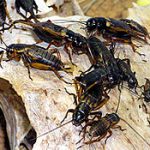Crickets, family Gryllidae (also known as “true crickets”), are insects somewhat related to grasshoppers, and more closely related to katydids or bush crickets (family Tettigoniidae). They have somewhat flattened bodies and long antennae. There are about 900 species of crickets. They tend to be nocturnal and are often confused with grasshoppers because they have a similar body structure including jumping hind legs. Crickets are harmless to humans.
The sound emitted by cricket is commonly referred to as chirping; the scientific name is stridulation. Only the male crickets chirp. The sound is emitted by the stridulatory organ, a large vein running along the bottom of each wing, covered with “teeth” (serration) much like a comb does. The chirping sound is created by running the top of one wing along the teeth at the bottom of the other wing. As he does this, the cricket also holds the wings up and open, so that the wing membranes can act as acoustical sails. It is a popular myth that the cricket chirps by rubbing its legs together.
Crickets are omnivorous scavengers who feed on organic materials, as well as decaying plant material, fungi, and some seedling plants. Crickets eat their own dead when there are no other sources of food available, and exhibit predatorial behavior upon weakened, crippled crickets.
Crickets have relatively powerful jaws, and have been known to bite humans, mostly without breaking the skin. The bite can, however, be painful when inflicted on sensitive skin such as the webbing between fingers.
Crickets mate in late summer and lay their eggs in the fall. The eggs hatch in the spring and have been estimated to number as high as 200 per fertile female. They lays eggs almost continually, with the females capable of laying at least twice a month. Female crickets have a long needlelike egg-laying organ called an ovipositor.
Crickets are popular as a live food source for carnivorous pets like frogs, lizards, tortoises, salamanders, and spiders. Feeding crickets with nutritious food in order to pass the nutrition onto animals that eat them is known as gut loading. In addition to this, the crickets are often dusted with a mineral supplement powder to ensure complete nutrition to the pet.

